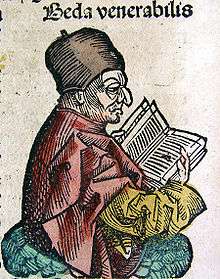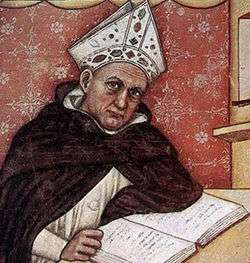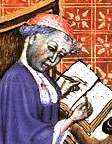List of medieval European scientists
Scientific activity in medieval Europe was maintained by the activity of a number of significant scholars, active in a wide range of scientific disciplines and working in Greek, Latin, and Arabic-speaking cultures. This list provides a brief summary of their work.
Anthemius of Tralles (ca. 474 – ca. 534), a professor of geometry and architecture, authored many influential works on mathematics and was one of the architects of the famed Hagia Sophia, the largest building in the world at its time. His works were among the most important source texts in the Arab world and Western Europe for centuries after.
John Philoponus (ca. 490–ca. 570), also known as John the Grammarian, a Christian Byzantine philosopher, launched a revolution in the understanding of physics by critiquing and correcting the earlier works of Aristotle. In the process he proposed important concepts such as a rudimentary notion of inertia and the invariant acceleration of falling objects. Although his works were repressed at various times in the Byzantine Empire, because of religious controversy, they would nevertheless become important to the understanding of physics throughout Europe and the Arab world.
Paul of Aegina (ca. 625–ca. 690), considered by some to be the greatest Christian Byzantine surgeon, developed many novel surgical techniques and authored the medical encyclopedia Medical Compendium in Seven Books. The book on surgery in particular was the definitive treatise in Europe and the Islamic world for hundreds of years.

The Venerable Bede (ca. 672–735), a Christian monk of the monasteries of Wearmouth and Jarrow who wrote a work On the Nature of Things, several books on the mathematical / astronomical subject of computus, the most influential entitled On the Reckoning of Time. He made original discoveries concerning the nature of the tides and his works on computus became required elements of the training of clergy, and thus greatly influenced early medieval knowledge of the natural world.
Rabanus Maurus (c. 780 – 856), a Christian monk and teacher, later archbishop of Mainz, who wrote a treatise on Computus and the encyclopedic work De universo. His teaching earned him the accolade of "Praeceptor Germaniae," or "the teacher of Germany."
Abbas Ibn Firnas (810 – 887), a polymath and inventor in Muslim Spain, made contributions in a variety of fields and is most known for his contributions to glass-making and aviation. He developed novel ways of manufacturing and using glass. He broke his back at an unsuccessful attempt at flying a primitive hang glider in 875.
Pope Sylvester II (c. 946–1003), a Christian scholar, teacher, mathematician, and later pope, reintroduced the abacus and armillary sphere to Western Europe after they had been lost for centuries following the Greco-Roman era. He was also responsible in part for the spread of the Hindu-Arabic numeral system in Western Europe.
Maslamah al-Majriti (died 1008), a mathematician, astronomer, and chemist in Muslim Spain, made contributions in many areas, from new techniques for surveying to updating and improving the astronomical tables of al-Khwarizmi and inventing a process for producing mercury oxide. He is most famous, though, for having helped transmit knowledge of mathematics and astronomy to Muslim Spain and Christian Western Europe.
Abulcasis (936-1013), a physician and scientist in Muslim Spain, is considered to be the father of modern surgery. He wrote numerous medical texts, developed many innovative surgical instruments, and developed a variety of new surgical techniques and practices. His texts were considered the definitive works on surgery in Europe until the Renaissance.
Constantine the African (c. 1020&–1087), a Christian native of Carthage, is best known for his translating of ancient Greek and Roman medical texts from Arabic into Latin while working at the Schola Medica Salernitana in Salerno, Italy. Among the works he translated were those of Hippocrates and Galen.
Arzachel (1028–1087), the foremost astronomer of the early second millennium, lived in Muslim Spain and greatly expanded the understanding and accuracy of planetary models and terrestrial measurements used for navigation. He developed key technologies including the equatorium and universal latitude-independent astrolabe.
Avempace (died 1138), a famous physicist from Muslim Spain who had an important influence on later physicists such as Galileo.[1] He was the first to theorize the concept of a reaction force for every force exerted.[2]
Adelard of Bath (c. 1080 – c. 1152) was a 12th-century English scholar, known for his work in astronomy, astrology, philosophy and mathematics.[3]
Avenzoar (1091–1161), from Muslim Spain, introduced an experimental method in surgery, employing animal testing in order to experiment with surgical procedures before applying them to human patients.[4] He also performed the earliest dissections and postmortem autopsies on both humans as well as animals.[5]

Robert Grosseteste (1168–1253), Bishop of Lincoln, was the central character of the English intellectual movement in the first half of the 13th century and is considered the founder of scientific thought in Oxford. He had a great interest in the natural world and wrote texts on the mathematical sciences of optics, astronomy and geometry. In his commentaries on Aristotle's scientific works, he affirmed that experiments should be used in order to verify a theory, testing its consequences. Roger Bacon was influenced by his work on optics and astronomy.[6]

Albert the Great (1193–1280), Doctor Universalis, was one of the most prominent representatives of the philosophical tradition emerging from the Dominican Order. He is one of the thirty-three Saints of the Roman Catholic Church honored with the title of Doctor of the Church. He became famous for his vast knowledge and for his defence of the pacific coexistence between science and religion. Albert was an essential figure in introducing Greek and Islamic science into the medieval universities, although not without hesitation with regard to particular Aristotelian theses. In one of his most famous sayings he asserted: "Science does not consist in ratifying what others say, but of searching for the causes of phenomena." Thomas Aquinas was his most famous pupil.
John of Sacrobosco (c. 1195 – c. 1256) was a scholar, monk, and astronomer (probably English, but possibly Irish or Scottish) who taught at the University of Paris and wrote an authoritative and influential mediaeval astronomy text, the Tractatus de Sphaera; the Algorismus, which introduced calculations with Hindu-Arabic numerals into the European university curriculum; the Compotus ecclesiasticis on Easter reckoning; and the Tractatus de quadrante on the construction and use of the astronomical quadrant.[7]
Jordanus de Nemore (late 12th, early 13th century) was one of the major pure mathematicians of the Middle Ages. He wrote treatises on mechanics ("the science of weights"), on basic and advanced arithmetic, on algebra, on geometry, and on the mathematics of stereographic projection.
Villard de Honnecourt (fl. 13th century), a French engineer and architect who made sketches of mechanical devices such as automatons and perhaps drew a picture of an early escapement mechanism for clockworks.

Roger Bacon (1214–94), Doctor Admirabilis, joined the Franciscan Order around 1240 where, influenced by Grosseteste, Alhacen and others, he dedicated himself to studies where he implemented the observation of nature and experimentation as the foundation of natural knowledge. Bacon wrote in such areas as mechanics, astronomy, geography and, most of all, optics. The optical research of Grosseteste and Bacon established optics as an area of study at the medieval university and formed the basis for a continuous tradition of research into optics that went all the way up to the beginning of the 17th century and the foundation of modern optics by Kepler.[8]
Ibn al-Baitar (died 1248), a botanist and pharmacist in Muslim Spain, researched over 1400 types of plants, foods, and drugs and compiled pharmaceutical and medical encyclopedias documenting his research. These were used in the Islamic world and Europe until the 19th century.
Theodoric Borgognoni (1205-1296) was an Italian Dominican friar and Bishop of Cervia who promoted the uses of both antiseptics and anaesthetics in surgery. His written work had a deep impact on Henri de Mondeville, who studied under him while living in Italy and later became the court physician for King Philip IV of France.
William of Saliceto (1210-1277) was an Italian surgeon of Lombardy who advanced medical knowledge and even challenged the work of the renowned Greco-Roman surgeon Galen (129-216 AD) by arguing that allowing pus to form in wounds was detrimental to the health of he patient.

Thomas Aquinas (1227–74), Doctor Angelicus, was an Italian theologian and friar in the Dominican Order. As his mentor Albert the Great, he is a Catholic Saint and Doctor of the Church. In addition to his extensive commentaries on Aristotle's scientific treatises, he was also said to have written an important alchemical treatise titled Aurora Consurgens. However, his most lasting contribution to the scientific development of the period was his role in the incorporation of Aristotelianism into the Scholastic tradition.
Arnaldus de Villa Nova (1235-1313) was an alchemist, astrologer, and physician from the Crown of Aragon who translated various Arabic medical texts, including those of Avicenna, and performed optical experiments with camera obscura.

John Duns Scotus (1266–1308), Doctor Subtilis, was a member of the Franciscan Order, philosopher and theologian. Emerging from the academic environment of the University of Oxford. where the presence of Grosseteste and Bacon was still palpable, he had a different view on the relationship between reason and faith as that of Thomas Aquinas. For Duns Scotus, the truths of faith could not be comprehended through the use of reason. Philosophy, hence, should not be a servant to theology, but act independently. He was the mentor of one of the greatest names of philosophy in the Middle Ages: William of Ockham.
Mondino de Liuzzi (c. 1270-1326) was an Italian physician, surgeon, and anatomist from Bologna who was one of the first in Medieval Europe to advocate for the public dissection of cadavers for advancing the field of anatomy. This followed a long-held Christian ban on dissections performed by the Alexandrian school in the late Roman Empire.
William of Ockham (1285–1350), Doctor Invincibilis, was an English Franciscan friar, philosopher, logician and theologian. Ockham defended the principle of parsimony, which could already be seen in the works of his mentor Duns Scotus. His principle later became known as Occam's Razor and states that if there are various equally valid explanations for a fact, then the simplest one should be chosen. This became a foundation of what would come to be known as the scientific method and one of the pillars of reductionism in science. Ockham probably died of the Black Plague. Jean Buridan and Nicole Oresme were his followers.
Jacopo Dondi dell'Orologio (1290-1359) was an Italian doctor, clock maker, and astronomer from Padua who wrote on a number of scientific subjects such as pharmacology, surgery, astrology, and natural sciences. He also designed an astronomical clock.
Richard of Wallingford (1292-1336), an English abbot, mathematician, astronomer, and horologist who designed an astronomical clock as well as an equatorium to calculate the lunar, solar and planetary longitudes, as well as predict eclipses.

Jean Buridan (1300–58) was a French philosopher and priest. Although he was one of the most famous and influent philosophers of the late Middle Ages, his work today is not renowned by people other than philosophers and historians. One of his most significant contributions to science was the development of the theory of impetus, that explained the movement of projectiles and objects in free-fall. This theory gave way to the dynamics of Galileo Galilei and for Isaac Newton's famous principle of Inertia.
Guy de Chauliac (1300-1368) was a French physician and surgeon who wrote the Chirurgia magna, a widely read publication throughout medieval Europe that became one of the standard textbooks for medical knowledge for the next three centuries. During the Black Death he clearly distinguished Bubonic Plague and Pneumonic Plague as separate diseases, that they were contagious from person to person, and offered advice such as quarantine to avoid their spread in the population. He also served as the personal physician for three successive popes of the Avignon Papacy.
John Arderne (1307-1392) was an English physician and surgeon who invented his own anesthetic that combined hemlock, henbane, and opium. In his writings, he also described how to properly excise and remove the abscess caused by anal fistula.
Nicole Oresme (c. 1323–82) was one of the most original thinkers of the 14th century. A theologian and bishop of Lisieux, he wrote influential treatises in both Latin and French on mathematics, physics, astronomy, and economics. In addition to these contributions, Oresme strongly opposed astrology and speculated about the possibility of a plurality of worlds.[9]
Giovanni Dondi dell'Orologio (c. 1330-1388) was a clockmaker from Padua, Italy who designed the astarium, an astronomical clock and planetarium that utilized the escapement mechanism that had been recently invented in Europe. He also attempted to describe the mechanics of the solar system with mathematical precision.
Notes
- ↑ Ernest A. Moody (June 1951). "Galileo and Avempace: The Dynamics of the Leaning Tower Experiment (II)", Journal of the History of Ideas 12 (3), p. 375–422 [379].
- ↑ Shlomo Pines (1964), "La dynamique d’Ibn Bajja", in Mélanges Alexandre Koyré, I, 442–468 [462, 468], Paris
- ↑ Haskins, Charles Homer (1967) [1926], "Adelard of Bath", Studies in the History of Medieval Science, New York: Frederick Ungar Publishing Co., pp. 20–42
- ↑ Rabie E. Abdel-Halim (2005), "Contributions of Ibn Zuhr (Avenzoar) to the progress of surgery: A study and translations from his book Al-Taisir", Saudi Medical Journal 2005; Vol. 26 (9): 1333–1339.
- ↑ Islamic medicine, Hutchinson Encyclopedia.
- ↑ A. C. Crombie, Robert Grosseteste and the Origins of Experimental Science 1100–1700, (Oxford: Clarendon Press, 1971)
- ↑ Pedersen, Olaf (1985), "In Quest of Sacrobosco", Journal for the History of Astronomy, 16: 175–221, Bibcode:1985JHA....16..175P.
- ↑ Lindberg, David C. "Theories of Vision from Al-Kindi to Kepler" University of Chicago Press 1976 pp. 94–187
- ↑ Dick, Steven J. (1984) [1982], Plurality of Worlds: The Origins of the Extraterrestrial Life Debate from Democritus to Kant, Cambridge: Cambridge University Press, pp. 35–7, ISBN 978-0-521-31985-0